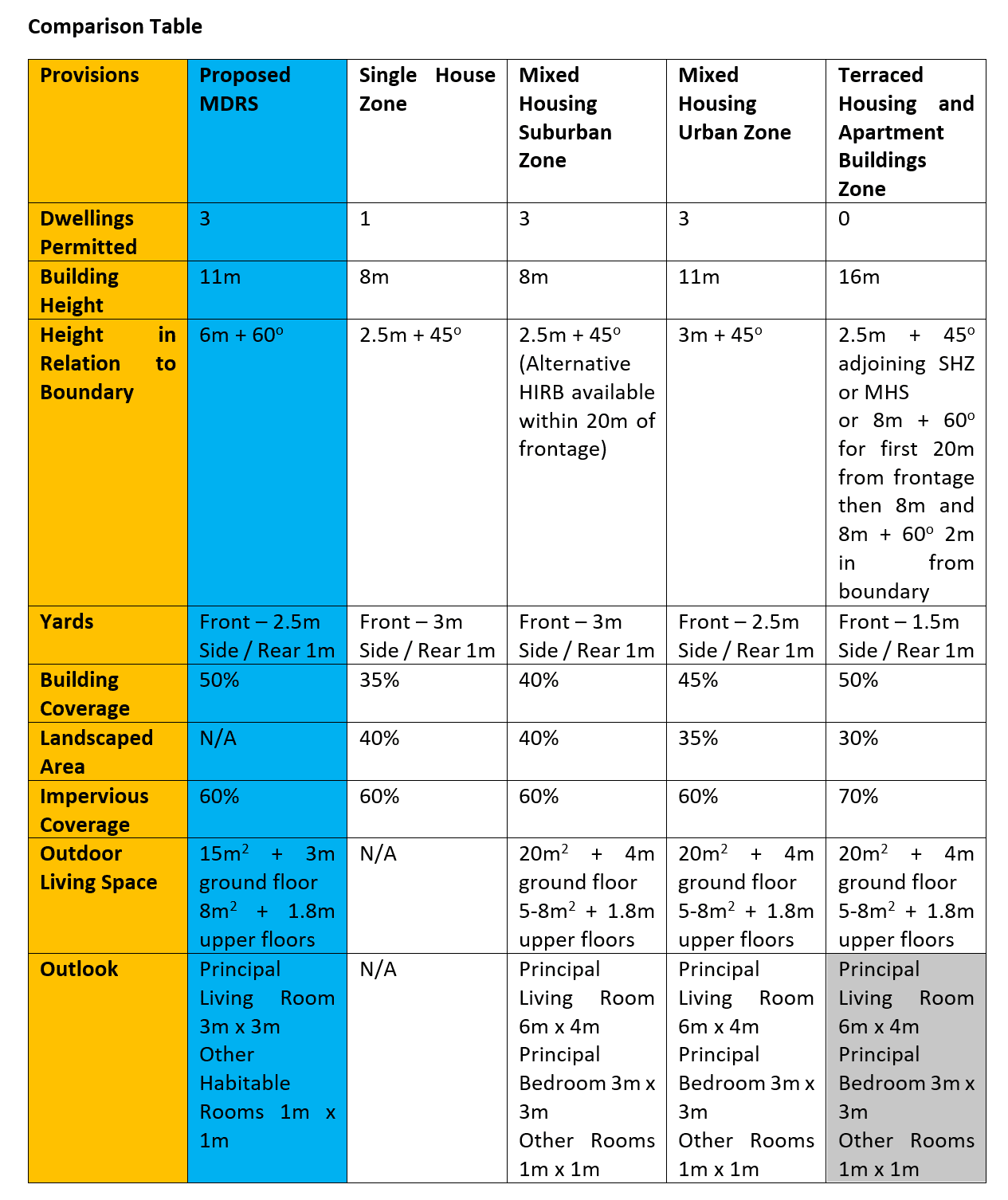Written by Peter Reaburn | Director | Cato Bolam Consultants
The purpose of these notes is to provide preliminary information, advice and observations on the new Bill. While the notes are focused on Auckland, the new Bill applies to all of New Zealand’s major (“Tier 1”) cities. These notes are circulated internally to Cato Bolam staff and may be shared with clients, on the express basis they should not be relied on without further consultation with Cato Bolam. The new Bill is not yet law and cannot be completely relied upon.
What is Happening and Why?
The purpose of the Bill, (which amends the RMA), seeks to rapidly accelerate the supply of housing and help to address some of the issues with housing choice and affordability. The Bill follows on from the National Policy Statement on Urban Development (the NPS-UD) that would have resulted in changes to plans to introduce greater / easier provision for intensification by August 2024. The Labour government, supported by National, has decided that is not quick enough. So the plan is that this Bill becomes law by Christmas with new standards for development (in Auckland and other Tier 1 cities) introduced by August 2022. The new standards will apply from the date they are notified (only proposals for greater flexibility will not apply immediately), and then will only be amended by a streamlined submissions and decision-making process after that, with (essentially) the Minister for the Environment having the final say.
Update
The New Housing Supply Bill passed its third reading and will shortly become law. The amendments to the RMA aim to rapidly accelerate the supply of housing to address some of the issues with housing choice and affordability that New Zealand currently faces in its largest cities. The new Medium Density Residential Standards (MDRS) will be introduced by councils, including Auckland Council, and have varying effect from August 2022.
We welcome you to read our most recent articles at the links below, or continue reading our preliminary observations.
MDRS – New Housing Rules – Auckland Intensifies
Resource Management (Enabling Housing Supply and Other Matters) Amendment Bill Passed
What is Proposed?
The Bill prescribes a set of Medium Density Residential Standards (MDRS). The MDRS will enable 3 storeys and 3 dwellings per site as of right, i.e. permitted activities on an existing site. An application for the construction or use of 4 or more residential units that comply with the MDRS must not be publicly notified or given limited notification.
Compared to current standards the MDRS will enable—
· more flexible height in relation to boundary standards to enable 3 storeys on average-sized sites;
· generally greater building coverage (although impervious surfaces remain the same as existing)
· smaller private outlook spaces (space between windows and other buildings) and private outdoor living spaces (for example, balconies);
· reduced yard setbacks (particularly, front yards);
· more resource consents (when needed) to proceed on a non-notified basis.
A summary of the new MDRS and how they compare to current zones in Auckland is attached to these notes.
Examples of how the new standards may apply are also attached to these notes.
No changes are proposed to minimum vacant site size requirements in plans. The only relevant requirement relating to subdivision is that there can be no minimum site size around a dwelling that is proposed under the MDRS. In Auckland at least, that applies already.
What are the Areas where the MDRS will apply?
The MDRS only applies in urban zones, i.e. it does not apply in rural zones or future urban zones. Any plan change that introduces a residential zone must apply the MDRS. Plan changes already underway that are inconsistent with the MDRS must be withdrawn. It appears to be possible, within the currently proposed provisions, for the Council to propose changes in current zonings where that is appropriate to give effect to the MDRS. This will become clearer once the Council has decided what it needs to, or wants to, do.
In any case, relevant territorial authorities are required to apply the MDRS to all existing residential areas, with the exception of two categories.
The first category of residential areas not included is any land zoned as large lot residential. These are described in the National Planning Standards as being areas used predominantly for residential activities and buildings such as detached houses on lots larger than those of low density residential and general residential zones, and where there are particular landscape characteristics, physical limitations or other constraints to more intensive development).
The second category of areas not included is where “qualifying matters” apply. “Qualifying matters” include:
· a matter of national importance that decision makers are required to recognise and provide for under section 6 of the Act;
· a matter required in order to give effect to a national policy statement (other than the NPS-UD);
· a matter required for the purpose of ensuring the safe or efficient operation of nationally significant infrastructure;
· open space provided for public use, but only in relation to land that is open space:
· the need to give effect to a designation or heritage order, but only in relation to land that is subject to the designation or heritage order:
· a matter necessary to implement, or to ensure consistency with, iwi participation legislation:
· the requirement in the NPS-UD to provide sufficient business land suitable for low density use, to meet expected demand:
· any other matter that makes higher density, as provided for in the MDRS inappropriate in the area.
The last bullet point in the above list will be interesting in the way that it plays out. An evaluation report as per section 32 of the Act must demonstrate why the Council considers that the relevant area is subject to a qualifying matter and justify why that view is the correct one. It remains to be seen what Auckland Council (and other Councils) will do in respect of constraints it may consider justified in areas that are not otherwise listed above as being qualifying matters. The most publicly indicated concern has been heritage and character areas, but there are other examples as well, such as volcanic viewshafts, protection areas around volcanic maunga and airport approach path noise protection areas. These are currently “unknowns” and it will only become clear what the direction is here once Auckland Council works through what they want to do.
What can be said with some confidence is that the new standards will apply to all current Mixed Housing Suburban and Mixed Housing Urban areas and most Single House Zone (SHZ) areas.
It is the SHZ areas where there will be the most impact. There are a lot of these areas in West Auckland, for example. It will be interesting to see what the reaction is going to be to proposals for more than 3 units in that zone. While an application for the construction or use of 4 or more residential units that comply with the building standards must not be publicly notified or given limited notification, that zone may still not enable more than 3 units without anon-complying activity resource consent. This is a “watch this space” matter.
It can also be said, with confidence, that the standards will be put in to the Terraced Housing and Apartment Buildings Zone to the extent that they introduce more flexibility than the current Zone. In other words, as examples, the new outdoor space standard will replace the current one but the (more permissive currently) height will remain.
Provision for residential activity is also provided for in some non-residential zones, e.g. the Mixed Use Zone. The Council must make changes to those zones, as necessary, to align with the MDRS.
The Process
It is important to note that the Bill is still to be introduced to Parliament. Once it has been introduced, there will be an opportunity for the public to submit on the proposals. There will undoubtedly be submissions. The final content of what becomes law, including the standards themselves, may yet change. So now is not the time to plan ahead on the basis of what is in the Bill. It is understood that the desire is to have the legislation in place this year (2021) but that is yet to be confirmed.
Once the legislation is in place an “intensification streamlined planning process” (the ISPP) is proposed to incorporate the MDRS into the plans (AUP). The following are the steps:
step 1: pre-notification consultation and engagement with iwi about the intensification planning instrument:
step 2: intensification planning instrument is notified and the MDRS has immediate legal effect:
step 3: submissions on the notified intensification planning instrument:
step 4: further submissions on the notified intensification planning instrument:
step 4a (optional): pre-hearing mediation:
step 5: independent hearings panel (IHP) to conduct hearings on the intensification planning instrument:
step 6: IHP report to territorial authority with recommendations:
step 7: territorial authority makes its decisions:
step 7a (if required): if the territorial authority does not agree with the IHP’s recommendations, the Minister for the Environment will become the decisionmaker:
step 8: intensification planning instrument is operative (including components that give effect to policies 3 and 4, or 5, of the NPS-UD).
It will be seen form the above that the IHP and, in particular, the Minister, have wide-ranging abilities in respect of the ultimate standards that will be applied, and in what areas. Auckland Council, as an example, may have its own idea on what should be in (and out), but that will then be considered by the IHP and then, if Council doesn’t agree with their recommendations, decided on by the Minister, with no right of appeal (although judicial review is a possibility). This is significant, as the IHP recommendations are not limited to the scope of submissions received by the IHP and may also include recommendations on other matters related to the intensification planning instrument. The Minister for the Environment can also either accept the IHP’s recommendations or make alternative recommendations. There will be some interest in this process, including where it may result in consequences that impose costs on development. As an example, Councils may, if they consider it appropriate to do so, include financial contributions provisions in the new package of provisions that are notified.
It is expected that the process will be fully complete sometime in 2023.
Immediate Implications
There is only a Bill at present and care needs to be taken in relying on what it proposes. It is likely that, for instance, private plan changes being proposed will take up the MDRSs in preference to the current framework of standards. By the time private plan changes (or any Council plan changes) are made operative the new provisions will likely be in place.
Strictly speaking, nothing changes until it changes. Applicants and Councils will still be subject to current rules, criteria, objectives and policies. There may be some shift in what is accepted, for instance as a restricted discretionary activity where current standards are exceeded and there is no doubt that developers will test this out. However, there will be a limit of acceptability. For instance, it would be too much of a challenge now to be proposing 3-story, 3-unit developments in the Single House Zone. Each development would need to be assessed on its merits and a call made as to how far the new legislation process has gone, where Council is at in its own thinking and what can be argued as meeting the formal planning framework that still applies. In all these respects it is going to be a challenge to explain to those who are interested in the flexibility encompassed in what is coming that it is not here yet.
Developers may wish to wait until the time is right to confidently benefit from the new provisions. For much development that is likely to be August 2022. However there will be a time between now and then that applications can be confidently put together, i.e. preparations made for what is coming. Any application in the system as at the notification date of the new MDRSs will be considered under that new regime.


